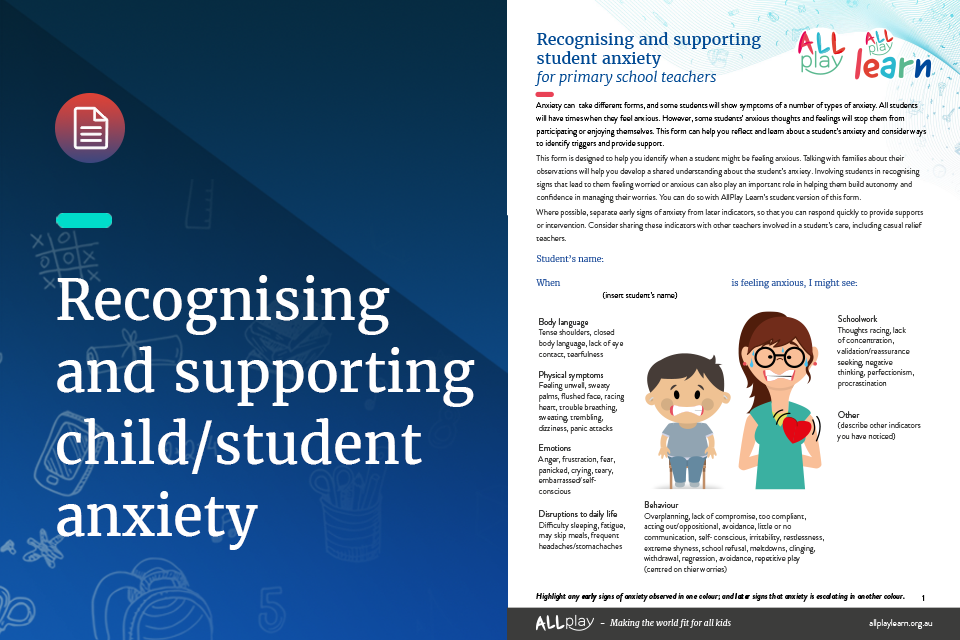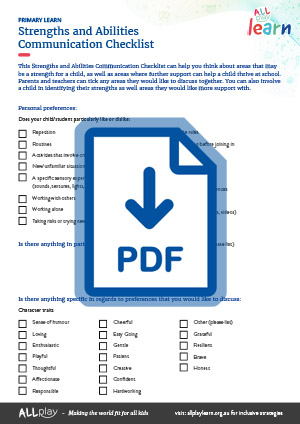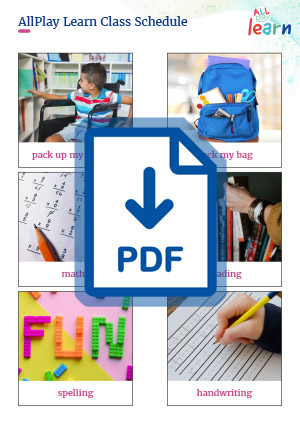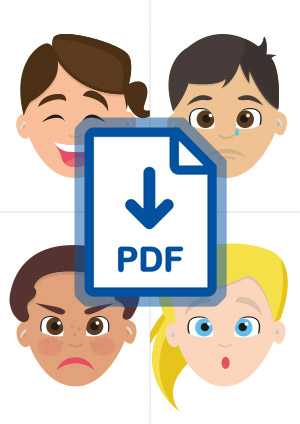

About anxiety
We all worry or feel scared at times, but some children may worry so much that they avoid participating in activities, being with others, or going places. Children with disabilities and developmental challenges often experience higher rates of anxiety than their peers. Anxiety can take different forms, and some children can show symptoms of a number of types of anxiety. You can learn about the different forms of anxiety below.
Separation anxiety
Selective mutism
Social anxiety
Specific phobias/anxiety
Generalised anxiety
Post-traumatic stress disorder
Panic disorder

Strengths
What might be some strengths?
- Some children with anxiety want their work to be perfect, and so their work may be high quality.
- Children with selective mutism may cooperate well with other children and obey the rules.
- Children with anxiety may connect with trusted adults or friends for support.
Where might you provide support?
- Worried and scared children usually try to avoid the thing that scares them. This could mean that they avoid or don’t join in some activities.
- They may look nervous or restless, or they may keep to themselves and avoid some activities or people. A child with anxiety who refuses to participate may be feeling overwhelmed rather than misbehaving or being stubborn.
- Some children who are really scared might cry and become very upset.
- Some students may refuse to attend school.
- They may seek lots of reassurance from staff and they may be upset if their work is not perfect. They might refuse to try something if they don’t feel they can do it well (particularly if others are watching), or throw their work away to start again.
- Some children may become very upset when separating from their family. Events that are out of routine, such as excursions, sports events, or camps may be very challenging.
- Anxiety can cause physical symptoms such as frequent stomach aches and headaches. This might affect their interest in class, or result in frequent sick bay visits.
- Children with anxiety may find it difficult to concentrate at times or appear restless.
- Anxiety can reduce a child’s ability to do well in a task, especially when they’re working in test-like conditions. This means that sometimes their results might not reflect their true capability.

Evidence-based strategies
Consider how you communicate
Adapt activities to be as inclusive as possible
Consider when and what type of feedback you give
Provide structure
Allow time to recognise and manage emotions
Activate social supports
Build skills and abilities
Provide a safe space
- Sit beside a child when talking/working with them. Work together on a specific activity rather than focus on the child.
- If a child doesn’t want to speak, you can think aloud. Give some time for the child to answer, and continue to talk with the child even if they do not speak.
- Some tasks may need to be modified. Allow children to face fears gradually – start at a level they can manage and build from there. Allow them to watch other children perform an activity/behaviour before they try.
- Allow extra time. If a child is anxious about sitting tests, give them extra time to complete the test. Also allow time to calm down before the test using strategies such as slow breathing. Remind them to pay close attention to the instructions. Give them time to feel comfortable with the place the test will be held and any examiners who will be there.
- Encourage and acknowledge effort. Children with severe anxiety may accept negative consequences for not doing what they are told rather than facing their fear. Encouraging a child for finishing or trying to do a task that makes them anxious can help to motivate them.
- Neutral responses for selective mutism. When a child has selective mutism it may be important to give a neutral response if they speak and not bring them unwanted attention. Ask the child’s parents how you should respond when their child speaks.
- Create a predictable environment. If there are going to be changes to the normal routine, tell the child beforehand, and give them a clear idea of what will happen instead.
- Provide clear rules and expectations. This way children know what is expected from them.
- See AllPlay Learn’s class schedule in the relevant resources below
- Spend a few minutes of each day doing simple relaxation exercises. This can be helpful for all children. Watch an example of a breathing and relaxation activity on the teacher resource page.
- Incorporate mindfulness practices. This can include educating students about emotions and mindfulness, as well as specific mindfulness exercises. For example, use tools such as emotion metres to help students recognise what emotions they are feeling.
- Provide time for positive interactions. Positive interactions with other children and staff can help all children.
- Talk to parents. Talk to parents to find out the best way to work with their child. Parents can help you understand a child’s unique strengths and areas they need support.
- Support students on arrival. Have a clear routine for the start of each day. If needed, have a teacher there who can help students say goodbye to their family and get organised for the school day.
- Consider peer mentoring opportunities. Mentoring programs can provide students with extra support and guidance. Pair younger students with older student mentors who can meet with, listen to, and provide mentees with attention and support.
- Support students with developing the skills and abilities to manage daily life demands. This can include activities which support self-awareness, coping with emotions, problem-solving and interpersonal relationships.
- Create a safe space. Create a space for children to use to reset and manage their anxiety. Tell them what they need to do when they want to go to that space. Let a child sit near their safe space so that they don’t attract attention from others when going there.
- Create a warm and fun environment. Be outwardly positive towards students and make sure disruptive behaviour is managed well.
- Don’t draw attention to a child with anxiety. Provide feedback or encouragement to children privately.
- Consider how you discipline. Children with anxiety might think whole class discipline is aimed at them personally, or they might be scared of any type of discipline that makes others notice them. Avoid whole class discipline or harsh or embarrassing discipline.
- Don’t punish if they are late. This is particularly important if they are anxious about coming to school.
- Acknowledge a child’s emotions. Provide warm and calm support to a child when they are distressed or anxious, and acknowledge how they are feeling.
- Model ‘brave’ behaviours. Watching others model brave behaviours and helpful coping behaviours can help children learn how to overcome their own fears.
View an example demonstrating how a teacher can use a strengths-based approach to apply evidence-based strategies to support a student with anxiety.

Best practice tips
Normalise mistakes
Make adjustments
Consider student stressors and experiences
Monitor your own emotions
Foster an inclusive and safe school environment
Be trauma-informed
Promote self-determination
- Teach students that making mistakes is normal. Some students may worry about making mistakes in their work. Tell the class regularly that mistakes are normal and they help us learn.
- Talk to students about tests. Before tests prepare students and normalise that some questions may be difficult while others will be simpler.
- Help students manage work output. For students who worry about having perfect work avoid giving them an extension, as they may then spend even longer worrying about making it perfect. If they are slow at finishing work you may need to praise them for how much they complete instead of praising or assessing the quality of their work within a set time.
- Be tolerant and patient with mistakes. Avoid pointing out mistakes in front of others. Make sure other students cannot see corrections.
- Help students manage reassurance seeking. Children with anxiety may check instructions often because they are worried about making a mistake. Give a calm and simple explanation, and ask them to write down their worries or save their questions for later (rather than repeatedly asking you questions). Encourage them when they work well by themselves. Write instructions on the board.
- Break large tasks or assignments down into smaller tasks. Large tasks may worry some students. Encourage students when they complete or attempt to complete smaller tasks.
- Try not to give tasks where students are timed. They may feel too stressed to work well.
- Let students work in small groups. They feel more comfortable talking to a few classmates than talking in front of the whole class.
- Create a safe space. Create a space for children to use to reset and manage their anxiety. Tell them what they need to do when they want to go to that space. Let a child sit near their safe space so that they don’t attract attention from others when going there.
- Collaborate with health professionals. If a health professional (e.g. psychologist) is working with a child, actively incorporating their suggestions at school can help provide opportunities for a child to manage their anxiety.
- For selective mutism, it can be helpful to have a child become comfortable speaking in one context before generalising to other contexts. Provide encouragement privately.
- For selective mutism, provide opportunities where appropriate for students to communicate non-verbally.
- Let children set goals. Give them opportunities to make choices or be part of making decisions.
- Make sure children and staff do not use stereotypes and biases. This includes ‘jokes’ that could upset children who have experienced trauma linked to gender, race or other cultural factors.
- Be informed about anxiety and the diverse ways it may present in school settings. For example, experiencing anxiety, including selective mutism, can be a distressing experience for children, and is not something a child chooses.
- Be aware of how you feel. Supporting a child with anxiety can at times be difficult, and you may feel frustrated. Being aware of your feelings and thoughts is important for a calm and supportive relationship with a child.
- Create a school culture around acceptance, inclusion and belonging. Promote a positive school culture by encouraging supportive relationships between peers and teachers, and student participation and engagement in school activities and learning. Visit AllPlay Learn's Inclusive Communities for Schools page to access a suite of resources to support you in building an inclusive school culture.
- Address bullying. Anti-bullying programs, which may include encouraging prosocial skills and bystander behaviour, can also promote a positive school climate that supports students experiencing anxiety.
- Create a trauma-informed environment. View AllPlay Learn's resources and strategies on creating trauma-sensitive school environments here.
- Promote self-determination. Empower and teach children to make simple choices, set goals, be independent, and develop problem-solving abilities. Use technology as needed. For example, technology can be used by students who communicate non-verbally to indicate preference.

Curriculum considerations

Other considerations
Assemblies
Relief teachers
Excursions and camps
Emergency drills
Behaviour
Separation
Transitions
Other co-occurring conditions
- Assemblies or other large gatherings may worry some students.
- Let children sit where they feel safe - perhaps near their teacher. As they feel less anxious, encourage them to sit closer to their classmates.
- Performing in front of others or receiving awards may cause anxiety. Start with what a child can do and build slowly from there.
- Changes in routine can be upsetting for many children with anxiety, and strangers leading a session may be particularly upsetting.
- If possible, tell parents of an absence in advance so they can prepare their child for the change.
- Support the relief teacher and child by informing them that the child may feel anxious and about strategies to best help the child.
- See AllPlay Learn’s story When my teacher is away under relevant resources below .
- Provide clear information about what will take place and consider pairing them with a buddy or safe person.
- Unexpected safety drills may upset some children with anxiety.
- Consider letting the child know beforehand that there will be a drill, and pairing them with a buddy or person they feel safe with.
- Some students might also show challenging behaviours. It’s important to remember children are most likely trying to communicate a need or want that is not being met.
- Refer to the ABC approach for more information on how to reduce challenging behaviour by supporting the child and promoting more helpful behaviour, and our emotions page for more information about supporting a child with managing their emotions.
- Some children may be upset when separating from their family in the morning.
- Provide warm and calm support to the child, and acknowledge how they are feeling.
- Provide a child with a safe space to start with if they are too upset to join the class immediately.
- Some children may separate more easily if they can start in the classroom before other children arrive, or if they can choose where their parent will say goodbye.
- If a child is becoming very upset at separation, and you have tried other strategies, it may help if a parent sits outside the classroom or comes in as a parent helper. This extra support can be gradually reduced as a child feels more confident.
- Some children with anxiety may need support when preparing for a move across education settings.
- Make clear links to what will be similar. Tell students what will be the same so that they know they already have some of the skills they will need.
- See some of the simpler year 7 school work. This helps students feel that they can manage high school work. It is important that the work is not more difficult than a student can already do.
- For more information about supporting students with disabilities when transitioning to a primary or secondary school setting access AllPlay Learn's transition page.
- Children with other developmental disabilities such as attention-deficit/hyperactivity disorder, autism, intellectual disability, specific learning disability or oppositional defiant disorder may often have high levels of anxiety.

Featured resource
AllPlay Learn’s Recognising and supporting student anxiety forms help teachers and students to reflect on:
- a student’s early signs that they are feeling anxious
- later signs that their anxiety is escalating
- triggers or contributors to the student’s anxiety
- strategies that may be effective at specific timepoints
Talking with families about their observations will help you develop a shared and richer understanding about the student’s anxiety. Involving students in recognising and responding to signs of anxiety can increase their autonomy and confidence. Some students may complete these forms independently, while others may find working with a trusted teacher, family member or health professional (e.g. their psychologist) helpful.
These forms can be used to support collaboration and communication across teaching staff, which can help create consistent supportive environments that foster a child’s sense of security and capability in managing their anxiety. You may also like to consider including these forms within an existing Individual Learning Plan to support the student throughout the year.

Relevant resources
Visit our resources page for a range of resources that can help to create inclusive education environments for children with disabilities and developmental challenges. Some particularly relevant resources for children with anxiety include:





